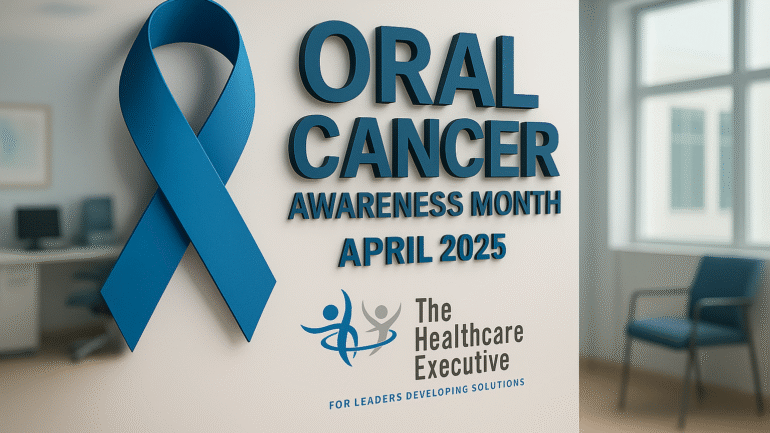Oral Cancer Awareness Month – April 2025

- Posted by Greg Wahlstrom, MBA, HCM
- Posted in Health Observance Calendar
Leadership Strategies for Prevention, Screening, and Early Detection
Published: April 29, 2025
April marks Oral Cancer Awareness Month, a timely reminder for hospital executives to advance prevention and screening initiatives through systemic leadership. Oral cancer affects more than 54,000 Americans each year, with early detection remaining the most critical determinant of survival. Health systems can improve outcomes by embedding screening protocols within primary care and dental settings, particularly for high-risk populations. Institutions like MD Anderson Cancer Center offer comprehensive head and neck cancer programs that serve as national models. These include multidisciplinary care teams, tobacco cessation support, and public education campaigns. Hospital leaders must ensure these practices are not isolated innovations but embedded elements of population health strategy. The time to shift from awareness to action is now.
The executive role in cancer prevention extends beyond campaign sponsorship—it includes data-driven planning, outreach accountability, and infrastructure development. With HPV-related oropharyngeal cancers on the rise, hospital CEOs should prioritize integration between oncology, dental medicine, and public health. Electronic health records (EHRs) can be configured to flag missed screening opportunities or overdue oral exams, especially among underserved groups. In our article Trust as a Strategic Asset, we emphasize how culturally competent communication builds credibility and increases care engagement. For oral cancer, this means delivering clear, consistent messages about symptoms, risk factors, and when to seek evaluation. Executive teams should track outreach KPIs, monitor equity in access, and collaborate with federally qualified health centers. True leadership means ensuring that care is not only available—but accessible, trusted, and used.
Workforce readiness is another critical component of oral cancer response. Many frontline providers, including nurses and dental hygienists, lack formal training in oral cancer identification and patient counseling. Healthcare executives can address this gap by funding continuing education programs, simulation training, and clinical shadowing within oncology settings. These investments improve early detection rates and foster interdepartmental collaboration. Organizations like the American Dental Association offer toolkits that make education scalable across departments. In our blog Nurses Deserve a Seat at the Table, we discussed the value of giving clinicians voice in hospital planning—oral cancer prevention requires exactly that. Leaders must create space for frontline expertise to shape outreach strategies and operational protocols. When staff feel supported and equipped, patient care improves systemwide.
Technology and innovation offer new tools for screening and diagnostics, but they must be implemented strategically. Mobile imaging tools, AI-assisted lesion detection, and predictive analytics are increasingly available in both clinical and community health settings. However, without proper governance, these tools can widen disparities rather than close them. Executives must ensure all new technology is evaluated through an equity lens and piloted with diverse populations. In our blog AI in the C-Suite, we caution that algorithmic design must include variables relevant to vulnerable groups. For oral cancer, this means ensuring tools detect symptoms across skin tones, age ranges, and comorbidities. Technology should augment—not replace—clinical judgment. With the right executive oversight, hospitals can implement innovations that expand reach while maintaining care quality.
As April 2025 concludes, hospital leaders must determine whether their engagement with oral cancer ends with the calendar—or begins with a strategy. Hosting screening clinics, embedding prompts in care workflows, and investing in education are all measurable actions. National organizations like the Oral Cancer Foundation and Head and Neck Cancer Alliance offer practical guidance, data, and community toolkits. At The Healthcare Executive, we believe that awareness campaigns must evolve into operational frameworks. The best time to launch those frameworks is now. April is a symbol—your strategy makes it substance.
Discover More
For executive insights on trust-building, workforce integration, and screening equity, explore these articles from The Healthcare Executive blog.
Internal Links
- Trust as a Strategic Asset: Reputation, Outcomes, and the Patient Voice
- Nurses Deserve a Seat at the Table
- AI in the C-Suite: Redefining Decision-Making for Healthcare Executives



